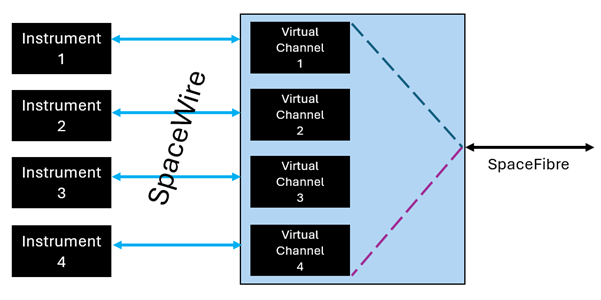We have introduced a system that bridges between SpaceWire and SpaceFibre links, providing a robust, high-speed communication solution for space applications. This innovation leverages our SpaceWire router IP core and SpaceFibre interface IP core, ensuring data transmission between the two protocols without the need for software intervention.
Understanding SpaceWire
SpaceWire is a well-established data communication protocol designed by the European Space Agency (ESA) for use in space applications. Operating at baud rates up to 400 Mbits/s, SpaceWire links are bi-directional, point-to-point communication links widely used in satellites and spacecraft.
Key features of SpaceWire include:
- Designed to withstand the space environment, SpaceWire uses error-detection and correction techniques like cyclic redundancy check (CRC) and packetization to ensure data integrity.
- SpaceWire is cost-effective and simple to implement, supported by numerous components and IP Cores.
- Each SpaceWire link includes a coder/decoder (CODEC) that encodes data packets into a serial bit-stream for transmission and decodes incoming serial bit-streams into data packets.
Advancing with SpaceFibre
SpaceFibre is a high-speed technology that builds upon the SpaceWire protocol, offering significantly higher data rates and enhanced capabilities.
Key features of SpaceFibre include:
- Capable of handling up to 6.25 Gbps per lane, providing a substantial upgrade in data transmission rates.
- Features built-in fault detection and recovery mechanisms, along with deterministic communication for consistent data transfer.
- Supports both copper and optical fiber, considerably reducing harness size
One of the standout features of SpaceFibre is its support for Virtual Channels (VCs). Virtual Channels allow multiple independent data streams to be multiplexed over a single physical link, providing some key benefits:
- Quality of Service (QoS): SpaceFibre’s Virtual Channels support various QoS levels, ensuring that different types of data receive appropriate levels of service. For instance, high-priority telemetry data can be assigned a higher QoS level to guarantee timely delivery, while lower-priority data can use a lower QoS level.
- Fault Isolation and Recovery: By segregating data streams into Virtual Channels, SpaceFibre enhances fault isolation. If an error occurs in one Virtual Channel, it does not affect the others, thus improving overall system reliability.
The New Bridging System: Integrating SpaceWire and SpaceFibre
Our system integrates the SpaceWire router with the SpaceFibre controller, creating a powerful bridge between these two protocols. This integration allows SpaceWire data from multiple payloads to be aggregated into a single SpaceFibre high-speed serial link without the need for software intervention. Additionally, data from a single SpaceFibre link can be distributed to multiple SpaceWire links, offering flexible and efficient bidirectional communication. A SpaceWire port of the router can be assigned to a Virtual Channel in the SpaceFibre network, applying the benefits of the SpaceFibre Virtual Channels – increased efficiency, fault isolation, and Quality of Service – to the SpaceWire network as well.

Applications
With this technology, multiple SpaceWire data streams from different subsystems can be aggregated into a single high-speed SpaceFibre link. This setup simplifies the onboard data routing and reduces the number of physical connections required. Additionally, the same SpaceFibre link can be used to distribute data to multiple SpaceWire endpoints, allowing for efficient and organized data management across the spacecraft.
Spacecraft equipped with high-data-rate scientific instruments, such as high-resolution cameras or spectrometers, require efficient data handling capabilities. The SpaceFibre link can handle high-speed data transfers from these instruments and aggregate this data using Virtual Channels. This aggregated data can then be transmitted over SpaceWire links to the spacecraft’s data processing units or storage systems, ensuring that high volumes of data are managed effectively without bottlenecks.
Implementation
With this technology being available in the form of VHDL IP cores within the GRLIB IP Library, the system can be implemented in any FPGA or ASIC technology. The features of the two IP cores (Spacewire Router – GRSPWROUTER, and SpaceFibre interface – GRHSSL) are documented in the GRLIB IP Core User’s Manual.
Furthermore, this system will be implemented in the GR765 – the next-generation radiation-hardened fault-tolerant octa-core system-on-chip, with the bootstrap option to select between LEON5FT SPARC V8 and NOEL-V RV64 RISC-V processor cores.
Conclusion
The integration of SpaceWire and SpaceFibre provides spacecraft with a powerful data communication tool with reduced complexity, and enhanced reliability. This technology supports a wide range of critical applications and enables system engineers to design more efficient data handling systems.